The cold winter brings new challenges to pig farming. As the temperature gradually drops, it may cause potential diseases, such as porcine epidemic diarrhea (PED) and porcine blue-ear disease (PRRS). Ensuring robust biosecurity measures in pig houses, along with a focus on feed safety, are key to helping reduce the risk of disease.
In addition to potential disease, air pollutants resulting from poor indoor ventilation can also negatively impact pigs and house staff. So pig houses that are closed during winter need to focus on indoor air quality. As well as avoiding health problems such as reduced growth rate and poor reproductive performance of pigs caused by cold stress.
Overall, these potential risks that come with winter could affect our normal farm operations. So our number one priority is to make sure these problems don’t get caught up in the winter, thus avoiding economic damage.
The main factors that affect air quality include:
1. Is it possible to ensure good ventilation in the venue?
2. Regional and seasonal changes
3. Feeding system and density
4. Animal Nutrition
Getting your barn ready for winter is key to focusing on air quality and nutrition. Some pollutants in pig houses are mainly ammonia, carbon dioxide, carbon monoxide, hydrogen sulfide, methane and some airborne microorganisms. Collectively, these pollutants adversely affect animals and, if not mitigated, can cause significant health and performance issues.
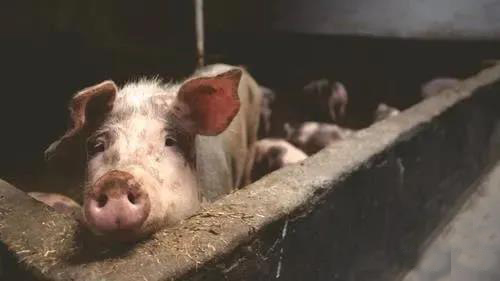 1. How cold stress affects feed intake
One nutritional challenge that pigs face when experiencing cold stress is increased metabolic heat production, which means they require more nutrients to maintain, but also directly affects pig growth. And in the process of cold stress, the greater ad libitum intake of pigs also leads to poor feed conversion rate, increased input costs, and decreased pork quality, which has a negative impact on cost control in general.
1. How cold stress affects feed intake
One nutritional challenge that pigs face when experiencing cold stress is increased metabolic heat production, which means they require more nutrients to maintain, but also directly affects pig growth. And in the process of cold stress, the greater ad libitum intake of pigs also leads to poor feed conversion rate, increased input costs, and decreased pork quality, which has a negative impact on cost control in general.
Why is this happening? In growing pigs, the thermoneutral zone is the most comfortable and productive zone in which pigs are able to maintain body temperature and perform optimally (Figure 1). Pigs experience cold stress when the temperature drops below the critical lower limit for pigs. When the temperature was lower than the critical lower limit, the feed intake increased, but the daily gain decreased.
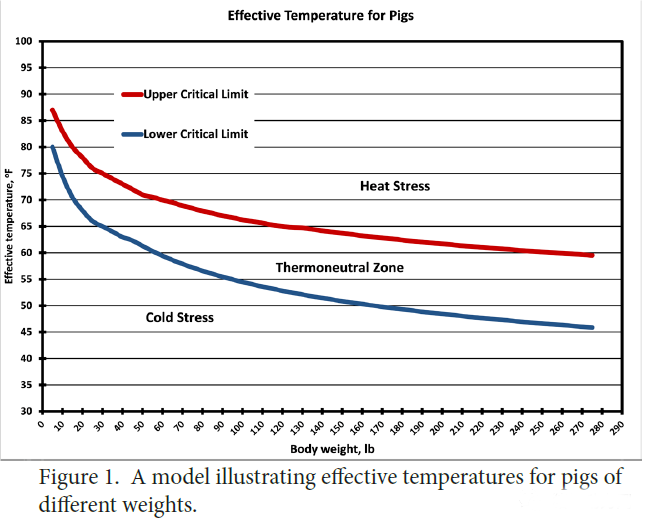 2、What does ammonia have to do with it?
Ammonia, a dangerous gas produced during the decomposition of urine, is a major source of air pollution in pig farms and negatively affects pig performance. Its harmful effects on pigs are:
2、What does ammonia have to do with it?
Ammonia, a dangerous gas produced during the decomposition of urine, is a major source of air pollution in pig farms and negatively affects pig performance. Its harmful effects on pigs are:
1. Reduce food intake
2. Decreased growth performance
3. Increased mortality
4. Reduced reproductive performance of sows
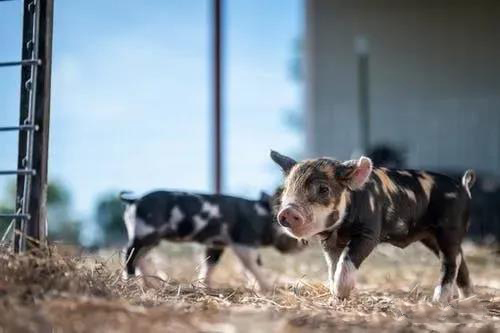 Ammonia is formed when excess nitrogen is excreted in urine and feces in the form of uric acid and urea. This is an issue that requires our attention because cold stress can affect the gastrointestinal tract of pigs, resulting in reduced nutrient intake and feed conversion ratios in pigs. And when a pig’s gastrointestinal tract is under stress, it cannot absorb nutrients properly, causing important nutrients to be excreted in waste.
3. 7 Tips to Prepare Your Pig House for Winter
01. Check your ventilation system
Static pressure is the driving force for ventilation. Check the pressure difference between the inside and the outside of the room and make sure that the main ventilation (usually side walls and ceiling entrances) are not restricted. Especially on older farms, check for condensation and leaks. The leaky pig house has poor ventilation in winter. Tune your ventilation system based on your environment and animal feedback.
02. Not all fans are created equal
Realize that each fan should be adjusted differently, and a 24-inch fan in one barn may not have the same effect as a 24-inch fan in another barn. Different environments can affect ventilation, so adjustments should be made accordingly. It is also important to know what the maximum static pressure of your equipment is. Also, remember to consider the fan’s energy efficiency and fan air flow ratio when starting to run the fan’s minimum ventilation in the coming months.
Extreme cold conditions can make cleaning, cleaning and disinfection of equipment and facilities very difficult. Dirty shutters and limited air intakes can negatively impact air flow, ventilation and air quality within the barn, which in turn can lead to poor livestock performance. Make sure blinds, shades, air intakes and other items are kept clean.
04. Fresh air distribution is critical
Make sure the fresh air is distributed correctly to avoid dead spots or cold spots throughout the barn. Proper placement and operation of barn air intakes and the use of static pressure are key. Make sure the air goes through your designated inlet and not through the cracks in the barn.
05. Insulate from cold surfaces
If possible, place materials such as insulating foam paper in front of cooling curtains, unused high-temperature fans, access doors, and other cold areas. Not only does this help create a better seal, but it also provides insulation from cold surfaces, just like regular wall heaters to pigs.
06. Make sure the barn is sealed
If the barn is not sealed, it is difficult to ensure proper ventilation. For example, if there are any leaks and/or cracks in the barn, the fresh air will take the path of least resistance and not be fully filtered, potentially negatively impacting on-site biosecurity. Ensuring the airtightness of the barn is about having complete control over how and where the air enters the barn.
07. Make sure your controller is set up correctly
Remember to clean the temperature probes and make sure they are in the correct location (eg: not too close to heaters or inlets etc). Make sure the temperature is measured correctly at the correct location in the barn to help better control the cost of propane heaters.
4. Nutrition Tips to Reduce Cold Stress in Pigs
01. Understand how the environment affects voluntary feed intake
Understanding the effects of cold weather on pig feed intake is extremely important. Timely adjustments to diet formulations are therefore key to ensure that as the weather cools, pigs get the nutrients they need while maintaining optimal animal performance。
02. Feed ingredients with high heat gain to pigs
Provide pigs with feed ingredients that produce more calories during digestion. This can be achieved by adjusting the fiber content of the feed. Fiber is highly digestible, so feeding more fiber to pigs will naturally produce more calories when the pig digests fiber. However, be aware that fiber can affect pork quality, as feeding high levels of fiber in finishing pigs can reduce pork production.
03. Reduce the crude protein content of the diet
Reducing the crude protein content of the diet can reduce nitrogen production, thereby reducing ammonia emissions in the barn.
04. Ammonia reduction in pig houses through feed additives
Deodorant from Alltech, a natural plant yucca extract rich in polysaccharide components, has been scientifically proven to reduce ammonia and its harmful effects in the environment, while increasing animal weight gain and feed efficiency, reducing Animal morbidity.
Deodorant effectively reduces the concentration of ammonia gas in pig houses
Deodorant increases average daily gain in pigs
Ammonia is formed when excess nitrogen is excreted in urine and feces in the form of uric acid and urea. This is an issue that requires our attention because cold stress can affect the gastrointestinal tract of pigs, resulting in reduced nutrient intake and feed conversion ratios in pigs. And when a pig’s gastrointestinal tract is under stress, it cannot absorb nutrients properly, causing important nutrients to be excreted in waste.
3. 7 Tips to Prepare Your Pig House for Winter
01. Check your ventilation system
Static pressure is the driving force for ventilation. Check the pressure difference between the inside and the outside of the room and make sure that the main ventilation (usually side walls and ceiling entrances) are not restricted. Especially on older farms, check for condensation and leaks. The leaky pig house has poor ventilation in winter. Tune your ventilation system based on your environment and animal feedback.
02. Not all fans are created equal
Realize that each fan should be adjusted differently, and a 24-inch fan in one barn may not have the same effect as a 24-inch fan in another barn. Different environments can affect ventilation, so adjustments should be made accordingly. It is also important to know what the maximum static pressure of your equipment is. Also, remember to consider the fan’s energy efficiency and fan air flow ratio when starting to run the fan’s minimum ventilation in the coming months.
Extreme cold conditions can make cleaning, cleaning and disinfection of equipment and facilities very difficult. Dirty shutters and limited air intakes can negatively impact air flow, ventilation and air quality within the barn, which in turn can lead to poor livestock performance. Make sure blinds, shades, air intakes and other items are kept clean.
04. Fresh air distribution is critical
Make sure the fresh air is distributed correctly to avoid dead spots or cold spots throughout the barn. Proper placement and operation of barn air intakes and the use of static pressure are key. Make sure the air goes through your designated inlet and not through the cracks in the barn.
05. Insulate from cold surfaces
If possible, place materials such as insulating foam paper in front of cooling curtains, unused high-temperature fans, access doors, and other cold areas. Not only does this help create a better seal, but it also provides insulation from cold surfaces, just like regular wall heaters to pigs.
06. Make sure the barn is sealed
If the barn is not sealed, it is difficult to ensure proper ventilation. For example, if there are any leaks and/or cracks in the barn, the fresh air will take the path of least resistance and not be fully filtered, potentially negatively impacting on-site biosecurity. Ensuring the airtightness of the barn is about having complete control over how and where the air enters the barn.
07. Make sure your controller is set up correctly
Remember to clean the temperature probes and make sure they are in the correct location (eg: not too close to heaters or inlets etc). Make sure the temperature is measured correctly at the correct location in the barn to help better control the cost of propane heaters.
4. Nutrition Tips to Reduce Cold Stress in Pigs
01. Understand how the environment affects voluntary feed intake
Understanding the effects of cold weather on pig feed intake is extremely important. Timely adjustments to diet formulations are therefore key to ensure that as the weather cools, pigs get the nutrients they need while maintaining optimal animal performance。
02. Feed ingredients with high heat gain to pigs
Provide pigs with feed ingredients that produce more calories during digestion. This can be achieved by adjusting the fiber content of the feed. Fiber is highly digestible, so feeding more fiber to pigs will naturally produce more calories when the pig digests fiber. However, be aware that fiber can affect pork quality, as feeding high levels of fiber in finishing pigs can reduce pork production.
03. Reduce the crude protein content of the diet
Reducing the crude protein content of the diet can reduce nitrogen production, thereby reducing ammonia emissions in the barn.
04. Ammonia reduction in pig houses through feed additives
Deodorant from Alltech, a natural plant yucca extract rich in polysaccharide components, has been scientifically proven to reduce ammonia and its harmful effects in the environment, while increasing animal weight gain and feed efficiency, reducing Animal morbidity.
Deodorant effectively reduces the concentration of ammonia gas in pig houses
Deodorant increases average daily gain in pigs



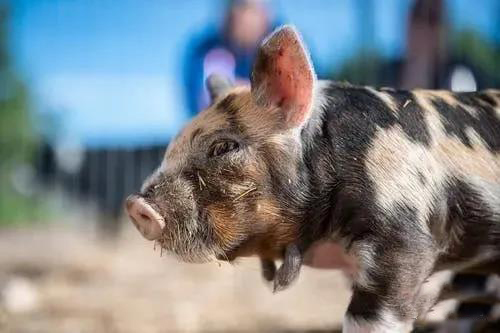
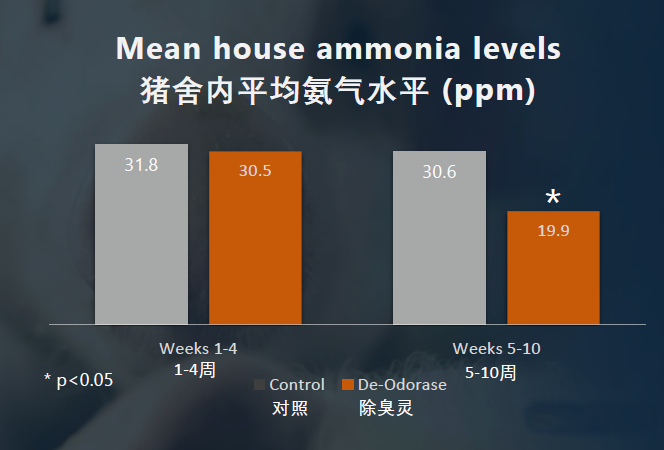
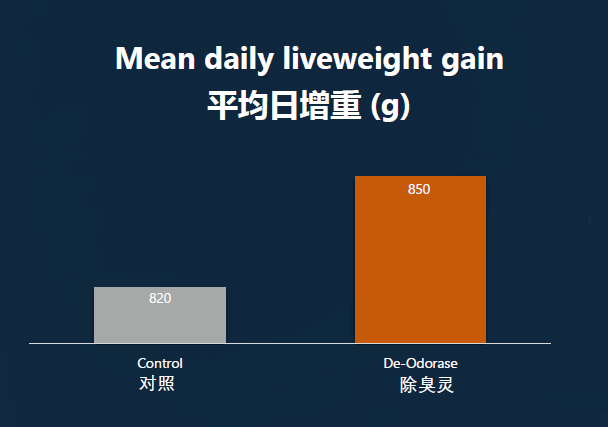

 QQ咨询
QQ咨询 拨打电话
拨打电话 在线留言
在线留言